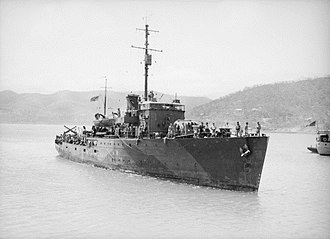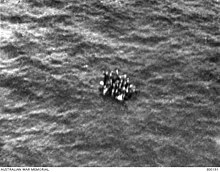HMAS Armidale (J240)
|
|
|
|---|---|

|
|
| period of service | |
| Builder: | Mort's Dock and Engineering Co Ltd , Sydney |
| Keel laying: | September 1, 1941 |
| Launch: | January 24, 1942 |
| Commissioning: | June 11, 1942 |
| Fate: | Sunk by Japanese aircraft off Timor on December 1, 1942 . |
| General properties | |
| Ship type : | corvette |
| Displacement : | 650 ts standard 1025 ts maximum |
| Length: | 57.7 m |
| Width: | 9.1 m |
| Draft : | 2.6 m |
| Drive : | 2 Admirality 3-drum steam boilers 2 3-way expansion steam engines 1,750 WPS on 2 screws |
| Speed : | 15 kn |
| Crew : | 83 |
| Armament: | 1 x 4 inches - gun 1 × 40 mm Bofors - Flak 3 x 20 mm Oerlikon-guns up to 40 water bombs |
The HMAS Armidale (J240) was a Bathurst-class corvette of the Royal Australian Navy during World War II . A total of 60 ships of this class were built during the war in Australia as part of the war emergency program as mine sweepers, 36 for the Royal Australian Navy (including the Armidale ), 20 on behalf of the British Admiralty , but manned and used by the Royal Australian Navy, and four more for the Royal Indian Navy . The corvette was the first ship to be named after the town of Armidale in New South Wales , Australia .
From its commissioning in June to October 1942, the Armidale escorted Australian coastal convoys and convoys between Australia and New Guinea under the command of Lieutenant Commander David H. Richards . In October she was assigned to the 24th demining flotilla in Darwin for use in the Battle of Timor , where she arrived on November 7th. On November 29th she set course for Betano together with HMAS Castlemaine . Fresh Dutch troops were to be landed there on the night of November 30th on December 1st and 190 Dutch soldiers and 150 Portuguese civilians were to be evacuated. On the way, the two corvettes were attacked three times by Japanese aircraft without any significant damage. At the landing site, however, no contact could be made with troops on land, which is why the ships retreated to the open sea so that they would not be within sight of the coast at daybreak. In the course of the day, the two ships came across the patrol boat HMAS Kuru , which was on its way to Darwin with 70 refugees on board. The refugees were taken to the Castlemaine , which took them to Darwin, while Armidale and Kuru independently returned to Timor . At 15:15 on the afternoon of the 1st December was Armidale of 13 Japanese planes attacked and sank within two five torpedo hits on the position 10 ° 0 ' S , 126 ° 30' O .
The survivors saved themselves in two boats and two rafts. The only motorized boat split from the others for help and was found by HMAS Kalgoorlie on December 6th . Australian scouts also sighted the rafts and the other boat, which had since separated from the rafts, but the Kalgoorlie could only find the boat whose 29 occupants she rescued on December 9th, the rafts remained missing.
A total of 40 crew members and 60 embarked Dutch soldiers lost their lives, including the seaman Edward Teddy Sheean . He was strapped to his 20-mm anti-aircraft gun after he had fired to the last despite being wounded and shot down one of the attacking machines. He was posthumously awarded the Victoria Cross , the highest military award in the Empire .
Today a patrol boat for the Australian Navy is operating under the name HMAS Armidale .
